Jun 02
Posted: under Activities, photography, Wildlife.
Tags: Activities, census, documentation, photography, wildlife management June 2nd, 2017
Yesterday morning as I went outside, I saw a very small cicada on the kitchen storm door. I thought immediately of one seen some years back (turned out to be four years) in the same place, photographed then and identified by Bill Reynolds, an expert on cicadas at BugGuide.net. First I went back inside and […] [...more]
Yesterday morning as I went outside, I saw a very small cicada on the kitchen storm door. I thought immediately of one seen some years back (turned out to be four years) in the same place, photographed then and identified by Bill Reynolds, an expert on cicadas at BugGuide.net. First I went back inside and got the camera, then photographed it, then went to BugGuide to compare…and sure enough, it’s the same critter. Length about 1/2 inch (not counting wings.)
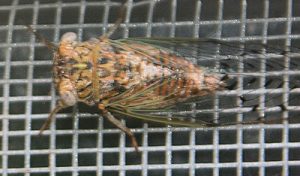 Pacarina puella Little Mesquite cicada
Pacarina puella Little Mesquite cicada
Read the rest of this entry »

Jul 08
Posted: under photography, Wildlife.
Tags: beauty, butterflies, census, native plants, photography, wildlife management July 8th, 2011
An unfamiliar plant shows up every now and then (more often after rains, and really often after flood events that move seeds from upstream above our property down into the damp areas.) Over the weekend, my husband reported a plant new to him over on Westbrook near the south fenceline: a Composite, very small flowers […] [...more]
An unfamiliar plant shows up every now and then (more often after rains, and really often after flood events that move seeds from upstream above our property down into the damp areas.) Over the weekend, my husband reported a plant new to him over on Westbrook near the south fenceline: a Composite, very small flowers and bicolored, like a miniature gaillardia, he said. Plant up to three feet tall, straggly, with narrow (lanceolate to linear) leaves. A couple of days later he brought back a drying specimen of the flowers; I tried to revive it in water so I could look it up, but no luck.
I finally made it over there early this morning, and as usual saw more than I came for. First, while walking through the south end of the creek woods, I heard a bird I didn’t recognize (along with white-eyed vireos, cardinals, Carolina wrens, mockingbirds…) and then I saw a flash of yellow and black…not a bird, but a large butterfly. We’ve had more and more tiger swallowtails in the past few years, both in the house yards and down in the creek woods, but I’ve had little luck photographing them. They’re strong flyers, skittish, and prefer to perch (when they perch) with plenty of greenery between me and them. Today I got lucky.
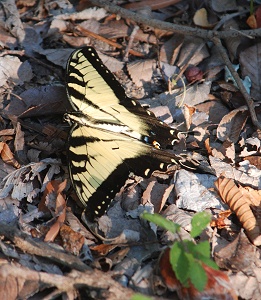 Read the rest of this entry »
Read the rest of this entry »

Jun 13
Posted: under Climate Change.
Tags: carbon cycle, climate, prairie restoration, wildlife management June 13th, 2010
Carbon sequestration is the trapping of atmospheric carbon (carbon dioxide) into some form where it can stay for decades. Carbon sequestration occurs naturally by the actions of plants, especially long-lived vegetation, and in certain soils, where it’s deposited as slow-decaying organic matter. Plants use sunlight to convert atmospheric carbon dioxide into the chemical that make […] [...more]
Carbon sequestration is the trapping of atmospheric carbon (carbon dioxide) into some form where it can stay for decades. Carbon sequestration occurs naturally by the actions of plants, especially long-lived vegetation, and in certain soils, where it’s deposited as slow-decaying organic matter. Plants use sunlight to convert atmospheric carbon dioxide into the chemical that make up plant material–simple sugars, to start with, then starches and more complex chemicals when added to other nutrients.
Why is this of interest in wildlife management or prairie restoration? The obvious reason is climate change caused by increasing carbon dioxide levels. Carbon sequestration by changes in management of both public and private lands is one way to get carbon dioxide out of the atmosphere and into plant materials. Many of the things a land manager might do to promote wildlife or restore an original ecosystem (forest or grassland) will have multiple benefits…including carbon sequestration.
Read the rest of this entry »

May 24
Posted: under Activities, Climate Change, Water, Wildlife.
Tags: Activities, amphibians, Animal behavior, beauty, documentation, observation, photography, wildlife management May 24th, 2010
Young Rana berlandieri with last of its tail showing. [...more]
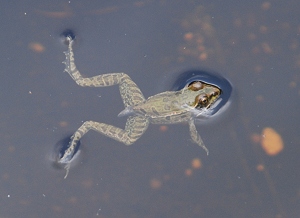 Young Rana berlandieri with last of its tail showing.
Young Rana berlandieri with last of its tail showing.
Read the rest of this entry »

May 10
Posted: under Activities, photography, Plantlife, Wildlife.
Tags: Activities, Animal behavior, beauty, butterflies, identification, insect, native plants, new species, photography, wildlife management May 10th, 2010
Because of time constraints (working on copy edits for new book) and weather, the brief walk on the land Saturday didn’t produce any usable bird pictures and I didn’t see any snakes or lizards, but I did see wildlife, large and small: [...more]
Because of time constraints (working on copy edits for new book) and weather, the brief walk on the land Saturday didn’t produce any usable bird pictures and I didn’t see any snakes or lizards, but I did see wildlife, large and small:
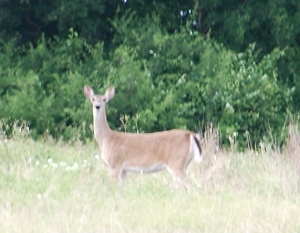 Read the rest of this entry »
Read the rest of this entry »

May 02
Posted: under Activities, photography, Plantlife, Wildlife.
Tags: Activities, beauty, native plants, water resource management, wildlife management May 2nd, 2010
We’re already drying up, though much is still green and flowers are still blooming…the long-range forecast is for a “mild drought.” Last summer, in the worst of the drought, we reworked the backyard water feature (which had become overgrown with water irises, among other things.) We started it before we had the 80 acres, designing […] [...more]
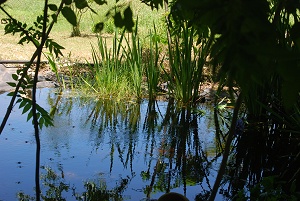
We’re already drying up, though much is still green and flowers are still blooming…the long-range forecast is for a “mild drought.” Last summer, in the worst of the drought, we reworked the backyard water feature (which had become overgrown with water irises, among other things.) We started it before we had the 80 acres, designing it for wildlife use from the beginning, with sunny, shady, quiet, and fast-moving sections of varying depths and shapes. In the extreme drought that ended last fall, it was crucial to our wildlife, because neither of the small guzzlers out on the 80 acres was big enough to sustain a good population of amphibians or odonates.
Read the rest of this entry »

Nov 25
Posted: under Activities, Mortality, Wildlife.
Tags: Activities, wildlife management November 25th, 2009
Wildlife managers know that in natural systems (few of which still exist) there’s a reasonable balance between predators and prey, so that the prey don’t degrade the resource (plants and water) they need. In nearly all managed lands in the US, large predators have been eliminated or reduced to the point where predators cannot effectively […] [...more]
Wildlife managers know that in natural systems (few of which still exist) there’s a reasonable balance between predators and prey, so that the prey don’t degrade the resource (plants and water) they need. In nearly all managed lands in the US, large predators have been eliminated or reduced to the point where predators cannot effectively control prey population. Thus the grazers and browsers can grow in numbers to the point where they are on the edge of starvation.
Read the rest of this entry »

Nov 07
Posted: under Activities, Wildlife.
Tags: Activities, bird behavior, census, observation, photography, wildlife management November 7th, 2009
Forgot to mention yesterday that though I had heard a White-crowned Sparrow call in the yard a few days ago, I hadn’t spotted one until yesterday evening, up in the dry woods. I came into the south end of the dry woods trail and startled some White-winged doves, who flapped off with their usual noisy […] [...more]
Forgot to mention yesterday that though I had heard a White-crowned Sparrow call in the yard a few days ago, I hadn’t spotted one until yesterday evening, up in the dry woods. I came into the south end of the dry woods trail and startled some White-winged doves, who flapped off with their usual noisy behavior, but one smaller bird just hopped to the top of a cactus and sat there.
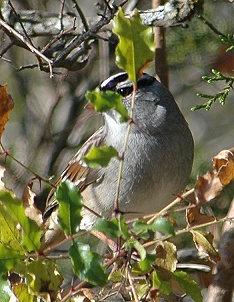 Read the rest of this entry »
Read the rest of this entry »

Nov 06
Posted: under Activities, photography, Wildlife.
Tags: Activities, census, insect, new species, observation, photography, wildlife management November 6th, 2009
Our on the land with visitors yesterday, I spotted a new fly (new to me): That spotted abdomen was very obvious with the naked eye. It’s a similar pattern to a spotted jumping spider we have (also white spots on black) and until I saw it fly I was thinking “There’s another P. audax, never […] [...more]
Our on the land with visitors yesterday, I spotted a new fly (new to me):
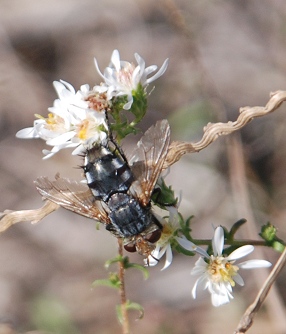
That spotted abdomen was very obvious with the naked eye. It’s a similar pattern to a spotted jumping spider we have (also white spots on black) and until I saw it fly I was thinking “There’s another P. audax, never saw one on heath aster before.” The “face” and antennae are the same golden color as the wings.
Read the rest of this entry »

Sep 08
Posted: under Activities, photography, Water, Wildlife.
Tags: Activities, photography, water resource management, wildlife management September 8th, 2009
One of the main activities for wildlife managers in Texas is providing supplemental water for wildlife. Where natural water supplies are abundant and unpolluted, supplemental water may not be necessary, but drought years come to all regions, and wildlife suffer if they do not have access to a reliable, safe, supply of water. In a […] [...more]
One of the main activities for wildlife managers in Texas is providing supplemental water for wildlife. Where natural water supplies are abundant and unpolluted, supplemental water may not be necessary, but drought years come to all regions, and wildlife suffer if they do not have access to a reliable, safe, supply of water.
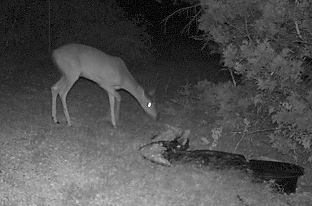
In a drought summer, with all natural water gone, deer made regular use of this small, three-tub water on a rocky knoll. Because of its small size, this waterer needed daily filling through the summer. A small solar-powered pump in the lowest tub circulates the water.
When considering water for wildlife, it’s important to set up a system for reliable (constant) water that is safe for wildlife to use and is provided in containers that allow access by a wide range of wildlife. This means thinking about the water source (rainwater, well water, stored surface water), water quality, and the shape, size, and location of water presentation.
Read the rest of this entry »









